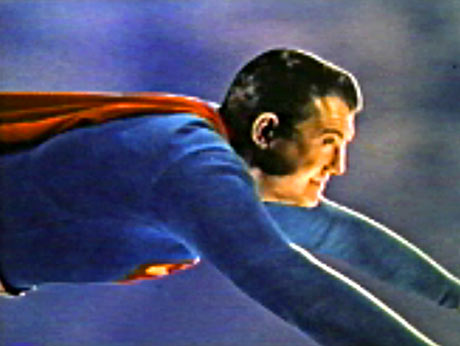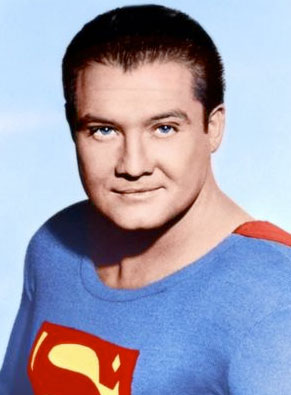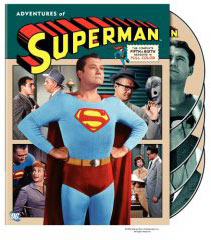
Who killed TV's Superman?
PART THREE
- by Jim Beaver
GEORGE REEVES' DEATH PART ONE HERE
 Jim Beaver writes in response to the article on TVparty! about the death of George Reeves, TV's Superman: I read your article on George Reeves with interest. I'm a fairly well-known actor, but I've got a side career as a film historian, and the George Reeves case has occupied my time for many years as I prepare a full-scale biography of Reeves. I was the biographical adviser on the film HOLLYWOODLAND, and I was asked several years ago to contribute to Cecil Adams's "Straight Dope" column on this subject. Here are my remarks for that column: Jim Beaver writes in response to the article on TVparty! about the death of George Reeves, TV's Superman: I read your article on George Reeves with interest. I'm a fairly well-known actor, but I've got a side career as a film historian, and the George Reeves case has occupied my time for many years as I prepare a full-scale biography of Reeves. I was the biographical adviser on the film HOLLYWOODLAND, and I was asked several years ago to contribute to Cecil Adams's "Straight Dope" column on this subject. Here are my remarks for that column:
You can read the entire article here.
There will always be speculation regarding the true circumstances of George Reeves's death, and there are very interesting questions supporting the various theories. I have been researching a full-scale biography of Reeves for many, many years (while simultaneously starring in the odd TV series here and there), and while I began my research with a presumption of foul play, I long ago came to a thus far unshaken conviction that Reeves did in fact commit suicide.
A few pertinent facts: A 2002 study reported in The Lancet showed that a person with a family history of even one suicide is 250% more likely to die by his or her own hand than someone with no family history of suicide at all. George Reeves had at least two suicides in his family (including the aunt from whom he got his middle name), and he had two prior unsuccessful attempts at suicide himself.
An inebriated person (Reeves's blood-alcohol content the night of his death was 2.5 times the legal limit) is ten times more likely to commit suicide than a sober person. A person with depression indicators is 30-to-90 times more likely to commit suicide than a non-depressive. An inebriated person with depression indicators is 300-to-900 times more likely to commit suicide than a sober person without depression indicators. (Source: National Institutes of Mental Health.). Reeves fit the 300-to-900 category.
 Much of what has been purported as fact in this case is actually not fact, and that which is factual has quite often been misinterpreted by lay persons who rely on "common knowledge" instead of actual forensic fact. I'll try to lay out some of the evidence and convey the scientific interpretation in contrast to the lay presumption. Much of what has been purported as fact in this case is actually not fact, and that which is factual has quite often been misinterpreted by lay persons who rely on "common knowledge" instead of actual forensic fact. I'll try to lay out some of the evidence and convey the scientific interpretation in contrast to the lay presumption.
Multiple bullet holes in the room: True, two holes were found in the floor, in addition to the death slug lodged in the ceiling. According to Dr. Edwin Schneidman, one of the world's leading authorities on suicide (whom I interviewed), some forty percent of gunshot suicides are preceded days or even weeks ahead by what he terms "practice shots," in which the suicidal person attempts to work himself up to the act. Add to this the occasional (but not consistent) testimony by Reeves' girlfriend that SHE fired the shots several days before, and you cannot build a compelling case FOR suicide from this evidence. Reasonable doubt, yes, but a strong case, no.
 No gunshot residue on Reeves' hand: Nowhere in the police or coroner's files is there any evidence that Reeves did not have gunshot residue on his hand. He was not tested for gunshot residue (a common omission in clear-cut suicides in 1959). Therefore no one knows whether such residue was there or not. You cannot build a case for or against suicide with gunshot residue evidence here, because there is no such evidence, one way or the other. No powder burns on the skin: Popular belief has it that an absence of powder burns MUST mean a weapon was fired from some distance away. It means nothing of the kind. One homicide detective actually told me "When I see powder burns in an apparent suicide, I start thinking murder." In a contact wound, where the muzzle of a pistol is pressed against the skin, all or virtually all of the gunpowder is projected INTO the wound track and leaves little or no stippling on the external body. A pistol would have had to have been either in direct contact with the skin OR twenty or more feet away in order not to leave any evidence on the skin of burning powder. There is no point in Reeves's bedroom that is more than eight feet from a wall. No gunshot residue on Reeves' hand: Nowhere in the police or coroner's files is there any evidence that Reeves did not have gunshot residue on his hand. He was not tested for gunshot residue (a common omission in clear-cut suicides in 1959). Therefore no one knows whether such residue was there or not. You cannot build a case for or against suicide with gunshot residue evidence here, because there is no such evidence, one way or the other. No powder burns on the skin: Popular belief has it that an absence of powder burns MUST mean a weapon was fired from some distance away. It means nothing of the kind. One homicide detective actually told me "When I see powder burns in an apparent suicide, I start thinking murder." In a contact wound, where the muzzle of a pistol is pressed against the skin, all or virtually all of the gunpowder is projected INTO the wound track and leaves little or no stippling on the external body. A pistol would have had to have been either in direct contact with the skin OR twenty or more feet away in order not to leave any evidence on the skin of burning powder. There is no point in Reeves's bedroom that is more than eight feet from a wall.
 Location of the gun: The gun was found on the floor between Reeves' feet, where it might easily have fallen, since he was shot while seated on the edge of the bed. Forensic pathologist Dr. Linda Norton (well known for doing the Lee Harvey Oswald re-autopsy) told me that due to reflex action, suicide guns are found all over the place and little credence is given to where a gun lands. She went on to state that between the feet of a (formerly) seated victim is a most natural spot for a gun to land. The empty shell casing WAS found under the body, a most natural circumstance, since the most natural position for holding a pistol to one's temple is with the gun nearly upside-down. If you have doubts try this test: Without thinking about it, quickly point at your temple. If you're like most people, your little finger will be toward your front and your index finger will be toward your back. If you imagine that your hand is holding a pistol, you will see that the top of the imaginary pistol is facing behind you rather than toward the ceiling. Such a position would eject the cartridge down and to the rear of the victim, hitting the bed much more quickly than the body could fall. Again, according to Dr. Norton and dozens of criminalists I've interviewed, there's nothing unusual about finding a spent cartridge under a (formerly) seated victim. Location of the gun: The gun was found on the floor between Reeves' feet, where it might easily have fallen, since he was shot while seated on the edge of the bed. Forensic pathologist Dr. Linda Norton (well known for doing the Lee Harvey Oswald re-autopsy) told me that due to reflex action, suicide guns are found all over the place and little credence is given to where a gun lands. She went on to state that between the feet of a (formerly) seated victim is a most natural spot for a gun to land. The empty shell casing WAS found under the body, a most natural circumstance, since the most natural position for holding a pistol to one's temple is with the gun nearly upside-down. If you have doubts try this test: Without thinking about it, quickly point at your temple. If you're like most people, your little finger will be toward your front and your index finger will be toward your back. If you imagine that your hand is holding a pistol, you will see that the top of the imaginary pistol is facing behind you rather than toward the ceiling. Such a position would eject the cartridge down and to the rear of the victim, hitting the bed much more quickly than the body could fall. Again, according to Dr. Norton and dozens of criminalists I've interviewed, there's nothing unusual about finding a spent cartridge under a (formerly) seated victim.
 The bullet was found in the ceiling: Continue with the imaginary gun pointed at your head. If you sit up straight, head erect, a bullet from that gun would pass through the temple and lodge most likely in the wall on the other side of you. However, imagine yourself so drunk you can barely sit upright (.27 blood/alcohol content, remember). Tilt your head to the right a little, "gun" still pointed at your temple. In this highly possible, perhaps highly likely position, a bullet traversing your temple would very likely lodge in the ceiling above your left side - precisely where the bullet that killed George Reeves was found. The bullet was found in the ceiling: Continue with the imaginary gun pointed at your head. If you sit up straight, head erect, a bullet from that gun would pass through the temple and lodge most likely in the wall on the other side of you. However, imagine yourself so drunk you can barely sit upright (.27 blood/alcohol content, remember). Tilt your head to the right a little, "gun" still pointed at your temple. In this highly possible, perhaps highly likely position, a bullet traversing your temple would very likely lodge in the ceiling above your left side - precisely where the bullet that killed George Reeves was found.
 No fingerprints found on the gun: The police report indicated that the gun was freshly oiled. Despite "common knowledge" to the contrary, a freshly oiled gun will NOT hold fingerprints. Fingerprints in even a thin coat of oil will dissipate just as they will in any other liquid. Prints are usually found when oil FROM THE FINGERS is deposited on a NON-oily surface. A wide variety of police officers and criminalists have been unanimous in providing this interpretation of the lack of fingerprints. (However, one detective DID suggest to me that sometimes a report indicating that no prints were found on a weapon was really a cover for the fact that a rookie patrolman had picked up the gun improperly and ruined whatever prints MIGHT have been there. There is nothing to suggest that this is what happened in the Reeves case. But either way, the lack of prints provides no meaningful evidence whatsoever as to who held the gun at the time of firing.) [Interpolation of information since this article: Detective Bill Clark of the NYPD (a lead detective in the Son of Sam case among others) told me that in his twenty-five-year career in homicide investigation, he had found fingerprints on a weapon only once, out of thousands of weapons. He said worrying about fingerprints on a weapon in a death investigation was a waste of time. You check, but you don't worry if they aren't there.] No fingerprints found on the gun: The police report indicated that the gun was freshly oiled. Despite "common knowledge" to the contrary, a freshly oiled gun will NOT hold fingerprints. Fingerprints in even a thin coat of oil will dissipate just as they will in any other liquid. Prints are usually found when oil FROM THE FINGERS is deposited on a NON-oily surface. A wide variety of police officers and criminalists have been unanimous in providing this interpretation of the lack of fingerprints. (However, one detective DID suggest to me that sometimes a report indicating that no prints were found on a weapon was really a cover for the fact that a rookie patrolman had picked up the gun improperly and ruined whatever prints MIGHT have been there. There is nothing to suggest that this is what happened in the Reeves case. But either way, the lack of prints provides no meaningful evidence whatsoever as to who held the gun at the time of firing.) [Interpolation of information since this article: Detective Bill Clark of the NYPD (a lead detective in the Son of Sam case among others) told me that in his twenty-five-year career in homicide investigation, he had found fingerprints on a weapon only once, out of thousands of weapons. He said worrying about fingerprints on a weapon in a death investigation was a waste of time. You check, but you don't worry if they aren't there.]
Reeves supposedly was not depressed at the time: Well, who ya gonna believe? I've got scores of interviews with friends of Reeves who will tell you that he was depressed as hell. I've got a good number of interviews with friends who state that he was not depressed. But most of the "not depressed" statements come from friends who hadn't seen him in a long time. Most of the "depressed" statements come from friends who saw a lot of him in the last weeks. He even gave interviews in the last month of his life that strongly suggest depression.
 He had just signed a new contract to do Superman again: According to an interview I had with Jack Larson, "Anyone who thinks another season of Superman wouldn't depress George didn't know George." Make of that what you will. I have no ax to grind, other than a dedication to the truth of the case. As I said, I began my work convinced that murder had happened. Cold, hard facts have prevented me from maintaining that belief. He had just signed a new contract to do Superman again: According to an interview I had with Jack Larson, "Anyone who thinks another season of Superman wouldn't depress George didn't know George." Make of that what you will. I have no ax to grind, other than a dedication to the truth of the case. As I said, I began my work convinced that murder had happened. Cold, hard facts have prevented me from maintaining that belief.
Who
Killed TV's Superman - part one / DC Comics on DVD here! |

Please consider a donation
so we can continue this work!
Amazon Prime - unlimited streaming
of your fave TV shows and movies!
Get your FREE 30 Day Trial!
PR4 & PR5 Pages for Advertising

|









